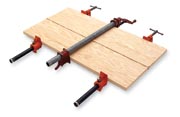
I am confused when I see directions for gluing parts together which say that the pieces must be perfectly flat. I know that there is no such thing as perfectly flat. What type of deviation or gap is really acceptable for the commonly used wood glues, like yellow, white, plastic resin, polyurethane and animal hide?
John Brock: I suppose it depends on your frame of reference. If you are used to the accuracies of a precision machinist, then you’re right, wood isn’t flat. I’m reminded of an old joke. One person asks, “How ya doin’ Joe?” Joe replies, “Compared to what?” For me, if I can close the pieces together with minimal clamping pressure and get a little squeeze-out, I’m happy. Don’t ever count on glue to fill gaps. That’s a fool’s errand. When edge gluing planks for a wide top, I like a little cupping so the ends touch first, and a little clamping pressure is required in the middle to close the gap. Then they tend to not skate around on the slick glue.





